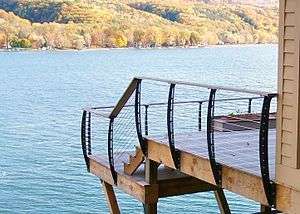Deck railing
Deck railing is a guard rail to prevent people falling from decks, stairs and balconies of buildings. Over time, many different styles of deck railing have been developed.
Deck railing designs
The most common[1][2][3] residential deck railing design is built on-site using pressure treated lumber, with the vertical balusters regularly spaced to meet building code. Cable railings typically use stainless steel cables strung horizontally.[4] Glass balusters and glass panels open the view while still providing safety.[5] With the increasing popularity of composite lumber for decking, manufacturers are providing composite railing components.[6] Other options include wrought iron and sheet steel, into which custom designs can be cut.
Deck railing and building code
Building code varies on the national, state, county and municipal level. Most areas in the world that use a variation of the International Building Code require a guard rail if there is a difference of 30" or more between platforms.[7] Other common requirements are that no space on the railing be greater than that through which a 4" sphere could pass and that the railing assembly be able to withstand a load of 50 pounds per square foot.[8]
Deck railing construction

The typical deck railing is generally built from pressure treated lumber. Posts on a deck are also typically pressure treated wood and standard sizes are 4x4, 6x6, and 8x8. These posts give structural support to the railing assembly and are the most critical part for the safety of the guard rail assembly.[9] In between the posts, two 2x4s are attached to the posts with screws for the best connection. The lower board is placed 3.5" from the top of the finish deck to the bottom of the board. The top board is placed with the top at 35" from the deck. Then the vertical 2x2 pressure treated wood balusters are installed spaced regularly every 3.5". Then a 2x6 is installed horizontally across the top of the posts and to 2x4. The 2x6 should be fastened with screws to the posts and 2x4 boards for the most rigidity.

Mountain laurel handrail, glass baluster systems, metal baluster systems, and composite railing systems all install in a similar manner. The differences is in the type of baluster installed. All four of these deck railings can be built using pressure treated lumber, another wood like cedar, or composite lumber to provide the structure.
Wrought iron and other metal railing systems that do not come in ready-to-install kits will usually require a skilled blacksmith as much welding will be required. These sections are typically built off-site in a workshop under controlled conditions, so that installation on the job site can be as speedy as possible.
Materials
- Aluminium
- Wood
- Wood-Plastic Composite[10]
- Vinyl
- Glass (panels)
- Galvanized steel
- Wrought iron
- Cable_railings
- Metal[11]
See also
References
- ↑ "Decking, Railing Market Share 2013".
- ↑ "Decking, Railing Market Share 2011".
- ↑ "Decking, Railing Market Share 1995" (PDF). Archived from the original (PDF) on 2012-09-15.
- ↑ "Cable Railing Construction".
- ↑ "Glass Balusters". Archived from the original on 2012-10-24.
- ↑ "Timber Tech Railing".
- ↑ "2006 International Building Code Requirements for Guard Rails".
- ↑ "Deck Railing Code Requirements".
- ↑ "Strong Rail-Post Connections for Wooden Decks" (PDF).
- ↑ Frane, David (2009). "Manufactured Deck Railings". Journal of Light Construction.
- ↑ "Deck Railing Ideas". Better Homes and Gardens.
`